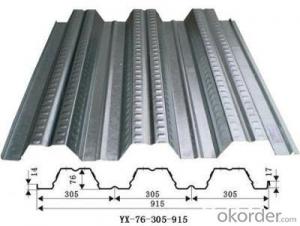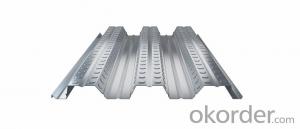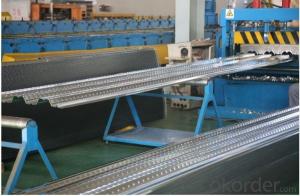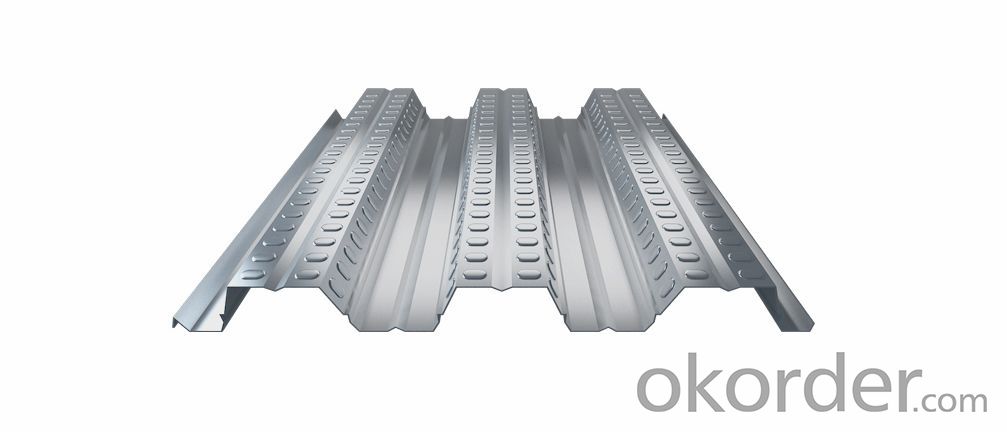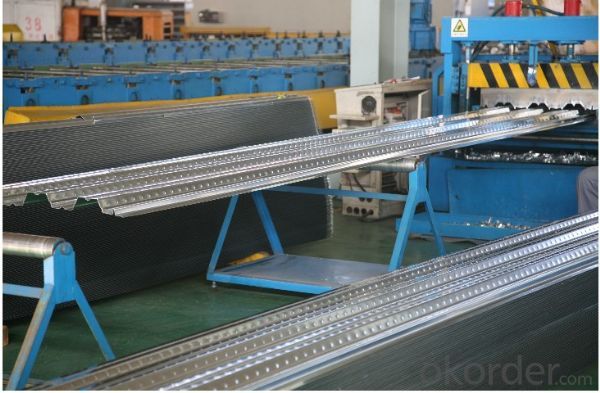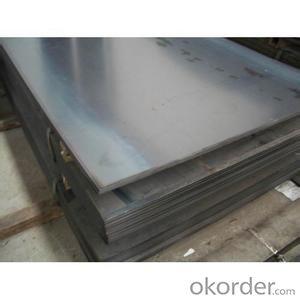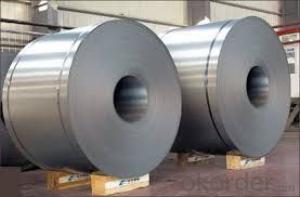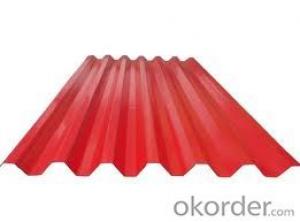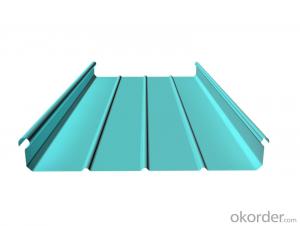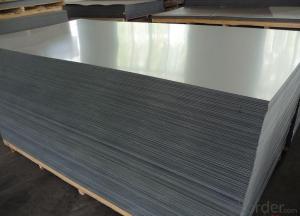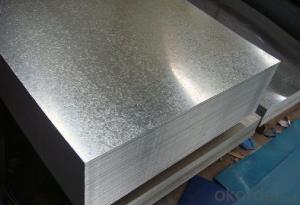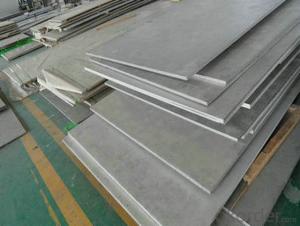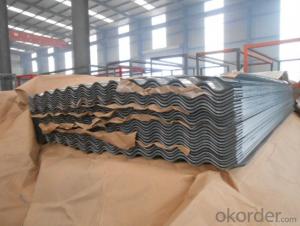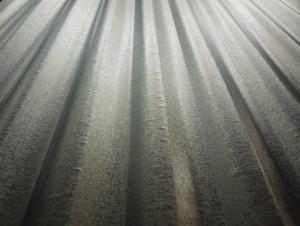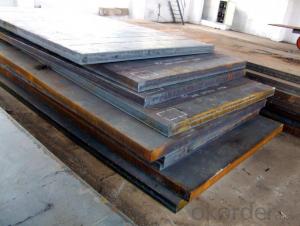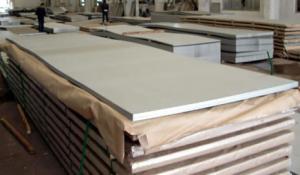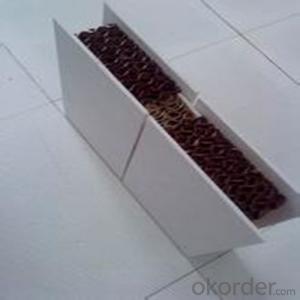Galvanised Steel Floor Board Decking Sheet
- Loading Port:
- Tianjin
- Payment Terms:
- TT OR LC
- Min Order Qty:
- 25 m.t.
- Supply Capability:
- 50000 m.t./month
OKorder Service Pledge
OKorder Financial Service
You Might Also Like
Product Description:
Specifications of corrogate sheets :
1) Capacity: about 15,000 tons per month for sheet product.
2) Standard: JIS G3302 1998, ASTM A653M/A924M 2004, all according to the customer's request
3) Thickness: 0.13mm-0.5mm
4) Width: 400mm-1000mm
5) Length: We can adjust the length according to your request
6) Zinc Coating Weight: 60g/m2-275g/m2
7) Raw Materials: Galvanized steel sheet and Pre-painted galvanized steel sheet
8) Spangle: Regular spangle, minimized spangle and zero spangle
9) Hardness: Full hard, normal
10) Color: RAL, or other series
11) Surface Protection: PE, PVC, PVDF, SMP, HDP, etc.
12) Min trial order 10 tons each thickness, 1x20' per delivery
Specification of corrogate sheets :
1) Chemical Composition: 55% Aluminum, 43.4% Zinc, 1.6% Silicon
2) Substrate: Galvalume steel sheet & Pre-painted galvalume steel sheet
3) Standard: JIS3321/ASTM A792M.
4) Thickness: 0.16mm-2.0mm, all available
5) Width: 600mm-1250mm, all available
6) Aluminum Coating: AZ50/AZ100/AZ150/AZ185
7) Spangle: regular spangle, minimized spangle, zero spangle
8) Surface treatment: Chemical treatment, oil, dry, anti-finger print
9) Color series: RMP/SMP/HDP/PVF2
10) Min trial order: 10 ton each thickness, 1x20' per delivery
Our Production Facility of corrogate sheets :
After we get the Galvanized sheet, Galvalume sheet, or Pre-painted Sheet, our Roof Panel Forming Machine can manufacture them as Corrugated Galvalume Roofing Sheet.
- Q: What is the maximum load-bearing capacity of steel sheets?
- The maximum load-bearing capacity of steel sheets depends on various factors such as the thickness, grade, and type of steel, as well as the specific application and support structure. Generally, steel sheets have high load-bearing capacities ranging from a few thousand pounds to several hundred thousand pounds per square inch, making them suitable for a wide range of structural and industrial applications.
- Q: How can the white steel plate be bright and cleaned?
- The use of detergent plus iron cloth rub, salt, vinegar 50 ml into the bowl, then add a little detergent thoroughly, with a cloth dipped in salt and vinegar detergent water rubbed white plate, not only can remove stains, can maintain the original brightness.
- Q: Can the steel sheets be bent or formed into different shapes?
- Steel sheets have the ability to be bent or shaped into various forms. Steel possesses exceptional malleability, enabling it to be effortlessly manipulated and molded without any risk of fracture. This advantageous characteristic facilitates a broad spectrum of applications requiring the bending or shaping of steel sheets, particularly in the construction sector, where beams, columns, and other structural elements necessitate specific configurations. Depending on the desired outcome and the steel's thickness, a range of techniques such as cold forming, hot forming, and press braking can be employed to accomplish the task of bending or shaping steel sheets.
- Q: What is the difference between a perforated and woven steel sheet?
- A perforated steel sheet is a metal sheet that has holes or perforations evenly distributed across its surface. These holes can be of various shapes and sizes, such as round, square, or slotted. Perforated steel sheets are commonly used in applications where airflow, visibility, or drainage is required, such as in architectural design, filtration systems, and acoustic panels. The main advantage of perforated steel sheets is their ability to provide these functionalities while still maintaining structural integrity. On the other hand, a woven steel sheet is a metal sheet that is made by interlacing steel wires together in a specific pattern. This interlacing creates a mesh-like structure, where the wires form a series of intersecting horizontal and vertical lines. Woven steel sheets are commonly used in applications that require strength, durability, and security, such as in fencing, guarding, and industrial filtration systems. The main advantage of woven steel sheets is their ability to provide a high level of strength and security due to the tightly interwoven wires. In summary, the main difference between a perforated and woven steel sheet lies in their respective structures and functionalities. Perforated steel sheets have evenly distributed holes across their surface, providing benefits such as airflow and visibility. Woven steel sheets, on the other hand, are made by interlacing steel wires together to form a mesh-like structure, providing benefits such as strength and security. The choice between the two depends on the specific requirements of the application at hand.
- Q: Are steel sheets suitable for architectural mesh applications?
- Yes, steel sheets are suitable for architectural mesh applications. Steel is a durable and versatile material, making it an excellent choice for architectural mesh installations. It offers strength, stability, and a wide range of design possibilities, making it ideal for various architectural purposes such as facades, partitions, shading, and decorative elements. Steel sheets can be customized in terms of size, shape, and pattern, allowing architects and designers to create unique and visually appealing structures. Additionally, steel's corrosion resistance properties make it suitable for both indoor and outdoor applications.
- Q: What are the bending and forming capabilities of steel sheets?
- Steel sheets have excellent bending and forming capabilities due to their inherent strength and malleability. They can be easily shaped into various forms, such as curves, angles, and complex geometries, through processes like bending, rolling, and stamping. This versatility makes steel sheets widely used in industries such as construction, automotive, and manufacturing.
- Q: What is the process of applying fire-resistant coatings to steel sheets?
- The process of applying fire-resistant coatings to steel sheets involves several steps. First, the surface of the steel sheets needs to be thoroughly cleaned to remove any dirt, grease, or contaminants. This can be done through abrasive blasting, solvent cleaning, or power washing. Once the surface is clean, a primer or base coat is applied to enhance adhesion and provide a smooth surface for the fire-resistant coating. The primer is typically applied using a brush, roller, or spray gun. After the primer has dried, the fire-resistant coating is applied. This coating is specifically designed to withstand high temperatures and provide protection against fire. It is usually applied in multiple layers for optimal effectiveness. The coating can be sprayed, rolled, or brushed onto the steel sheets. Once the fire-resistant coating is applied, it needs to cure or dry according to the manufacturer's instructions. This curing process ensures that the coating forms a strong bond with the steel surface and achieves its maximum fire-resistant properties. Overall, the process of applying fire-resistant coatings to steel sheets involves surface preparation, primer application, fire-resistant coating application, and curing. It is crucial to follow proper application techniques and adhere to manufacturer guidelines to ensure a durable and effective fire-resistant finish.
- Q: How do steel sheets perform in terms of electrical resistance?
- Compared to other materials, steel sheets exhibit a comparatively higher electrical resistance. Consequently, their conductivity falls short in comparison to metals such as copper or aluminum. The electrical resistance of steel sheets may fluctuate depending on variables like the sheet's composition and thickness. Generally speaking, steel sheets are regarded as inadequate conductors of electricity. Nevertheless, it is crucial to acknowledge that the application of specific coatings or treatments to the steel surface can diminish the electrical resistance.
- Q: What are the properties of deep drawing properties in sheet steel?
- Refers to the change of the thickness of steel plate and the change of plane (length and width direction) when the steel plate is pressed.
- Q: Can steel sheets be used for insulation in buildings?
- No, steel sheets cannot be used for insulation in buildings. Steel is a highly conductive material, meaning it allows heat and cold to transfer easily through it. Insulation, on the other hand, is designed to prevent the transfer of heat, cold, or sound. Therefore, materials such as fiberglass, mineral wool, foam board, or cellulose are commonly used as insulation in buildings, as they have low thermal conductivity and can effectively reduce heat loss or gain.
Send your message to us
Galvanised Steel Floor Board Decking Sheet
- Loading Port:
- Tianjin
- Payment Terms:
- TT OR LC
- Min Order Qty:
- 25 m.t.
- Supply Capability:
- 50000 m.t./month
OKorder Service Pledge
OKorder Financial Service
Similar products
Hot products
Hot Searches
Related keywords
